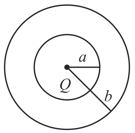Embibe Experts Solutions for Chapter: Electrostatics, Exercise 3: Exercise - 3
Embibe Experts Physics Solutions for Exercise - Embibe Experts Solutions for Chapter: Electrostatics, Exercise 3: Exercise - 3
Attempt the free practice questions on Chapter 22: Electrostatics, Exercise 3: Exercise - 3 with hints and solutions to strengthen your understanding. Alpha Question Bank for Engineering: Physics solutions are prepared by Experienced Embibe Experts.
Questions from Embibe Experts Solutions for Chapter: Electrostatics, Exercise 3: Exercise - 3 with Hints & Solutions
A tiny spherical oil drop carrying a net charge is balanced in still air with a vertical uniform electric field of strength . When the field is switched off, the drop is observed to fall with terminal velocity . Given , viscosity of the air and the density of oil , the magnitude of is :
A charge is uniformly distributed over a long rod of length as shown in the figure. The electric potential at the point lying at distance from the end is

Assume that an electric field exists in space. Then the potential difference where is the potential at the origin and the potential at is
A long cylindrical shell carries positive surface charge in the upper half and negative surface charge in the lower half. The electric field lines around the cylinder will look like figure given in (figures are schematic and not drawn to scale)
A uniformly charged solid sphere of radius has potential (measured with respect to ) on its surface. For this sphere the equipotential surfaces with potentials have radius and , respectively. Then
The region between two concentric spheres of radii and , respectively (see figure), has volume charge density , where is a constant and is the distance from the centre. At the centre of the spheres is a point charge . The value of such that the electric field in the region between the spheres will be constant, is

An electric dipole has a fixed dipole moment , which makes angle with respect to axis. When subjected to an electric field , it experiences a torque . When subjected to another electric field it experiences a torque . The angle is
Three concentric metal shells of respective radii have surface charge densities , respectively. The potential of shell is,
